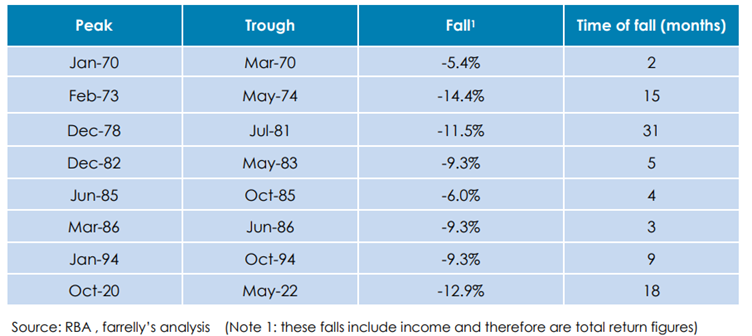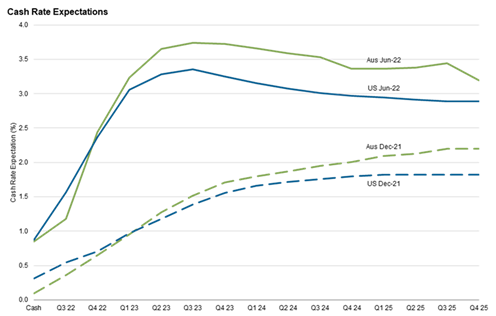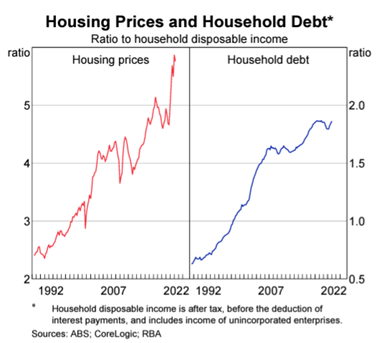Interest rates are certainly on the rise, so much so that the recent sell off in bonds has been the biggest seen in almost 50 years. Keep in mind that as interest rates go up, the capital value of existing bonds go down. Looking back through history, the scale of the selloff is not that unusual, what is unusual is the time period between this one and the previous fall – 28 years.
The last fall of similar magnitude occurred in 1994 however, in the 24 years prior to 1994 there were no less than 6 significant bear markets.
Australian Bond bear markets since 1968

What caused the difference in bond market volatility? In short, inflation. Between 1994 and 2021, inflation had been relatively stable and falling.
A near perfect storm of events has led to the re-emergence of inflation. Post 1970, world trade benefited immensely from the globalisation concept. Supply chains were dramatically impacted as the production of goods shifted to the country with the lowest cost producer while incredible advancements in the shipping of resources facilitated just in time production.
It took a global pandemic, with the demoralising death of millions, to disrupt global supply chains via economy wide shutdowns. The rise of populist governments then ensured that there were large fiscal responses to shore up domestic economies and central banks dutifully followed suit, pumping billions of dollars into the financial system.
It almost appears that we had forgotten the lessons of the past as we believed that we had entered a new regime where inflation had been permanently conquered and central banks could simply print new money at will without any impact upon prices. To be fair, this line of thinking seemed to be factually correct for an extended period of time.
It now appears that reality has struck, thanks to those shutdowns, an outbreak of war in a strategic supplier of commodities, floods and shortages of labour thanks to the lack of human migration.
Inflation has once again spiked, however, the outlook for inflation in the years ahead is divided into two distinct camps. On one side there is a belief that a large portion of the inflation we are witnessing is due to the supply chain constraints and the war in Ukraine. If this is correct, we should see an easing of inflation in the next twelve months as supply constraints ease. This is largely dependent upon China easing its Covid Zero regime.
The other camp is of the belief that inflation is now more structural in nature, spurred on by a focus on switching supply chains back to domestic economies which takes a long time and comes at a large cost and large amounts of government largesse. In this situation consumption demand will remain elevated, outstripping supply and thereby pushing prices higher.
The big questions are whether central banks will be able to tame inflation and how high will inflation go before it is once again under control. No matter which camp you fall into, there is no question that interest rates will be heading higher for some time.
Where to for interest rates?
Decisions on interest rate movements are not an exact science, it is mostly guesswork on the part of the central banks. Central banks are often trying to encourage or discourage economy wide spending, savings and borrowing. While they have multiple tools at their disposal, determining how hard to pull on one lever or another is often based upon experience and guesswork.
It is fair to say that almost all market analysts expected the Reserve Bank of Australia (RBA) to once again lift interest rates at this week’s meeting. The only conjecture was by how much.
Consensus had the rate increase just favouring 0.25% over a 0.40% rate hike. So, the fact that they raised rates by 0.50% surprised many. The last time they raised interest rates by 0.50% was way back in 2000. The full statement by the RBA Governor can be found here.
The following chart shows just how quickly and dramatically the markets expectations of where interest rates are headed have changed.

Source: PIMCO Investment Management
Following the rate increase, the 3-year Australian Commonwealth bond yield was trading at 3.15% and the 10-year at 3.54% a far cry from where they were only six months ago and hence the reason for the bond bear market.
The magnitude of the cash rate increase seems to indicate a shift in thinking at the RBA. Only last month they were talking about a return to normal rate increases of 0.25%. The RBA had also previously indicated that they wanted to see wages rise by at least 3% p.a. before they would consider rate increases. With wages currently running at 2.2% it looks like the RBA has switched from a wait and see attitude to the pre-emptive strike camp that the Reserve Bank of New Zealand has been leading.
Are we in an inflationary spiral?
Over the coming weeks and months, you will hear a lot more talk about stagflation, an economic term indicating a period of low growth, high inflation and stubbornly high unemployment. All attributes that generally lead to poor investment market returns.
While inflation is likely to remain elevated in the next twelve months, we believe the chances of falling into a stagflationary environment remain low. For the current inflation surge to continue, central banks will need to turn out to be too meek in their responses – for many years, and it certainly looks like they have no intention of easing off the interest rate increases.
While the cash rate will continue to rise, we expect the cash rate to be at least 1.75% by the end of the year, we also believe the bond market is pricing in too much. From the chart above, the market expects the cash rate to reach 2.50% by December 2022 and 3.75% in 2023. That equates to a rise of 1.65% in the next six months alone.
The RBA governor has previously stated that he believes the neutral cash rate in Australia sits around 2.50%. At that level, the economy should be in balance with full employment, maximum output (GDP growth) while keeping inflation constant. Moving higher than that rate risks plunging the economy into a recession.
Recall that the RBA is currently trying to restrain the speed of economic growth, it wants each and everyone of us to slow down our spending. By raising interest rates, they hope consumers will start to be more price sensitive in regards to spending and it would also be nice if they could switch from a spend to save mentality.
How far the RBA needs to raise rates depends on how price sensitive we consumers are. If we manage to push wages higher to match inflation, then rates will also be headed higher. If however, the rate increases start to bite, then the terminal rate will be closer to the 2.50% neutral rate.
The following chart from the RBA highlights just how high house prices and debt levels have moved as a ratio of household disposable income.

With consumer debt higher than pre GFC levels, the RBA will not have to increase interest rates too much to achieve the outcome that they want. Again, if they push interest rates too high, they risk crushing the housing sector and triggering a recession. That is not their intent though it must be noted again it is an imperfect science when setting interest rates.
Lastly, there has been talk from some commentators that Australian borrowers are not as sensitive to rate increases now that approximately 40% of all loans are fixed rate loans. While it is true that an increasing number of Australians have locked in low interest rates, unlike our American counterparts, we have selected short lock in periods as the following graphic highlights.
Structure of bank residential property lending portfolios

Source: Company reports, Farrelly’s
The vast majority of fixed rate loans will need to be renegotiated before December 2023 indicating that these borrowers will still be watching rate increases with morbid fascination and wondering how they will cope when their fixed rate loan lapses.
What are the investment implications?
Unfortunately, market volatility will remain with us for some time yet as the doom and gloom talking heads hit the airwaves spruiking stories of never-ending price rises. We will continue to see the RBA lift interest rates over the course of the next six months and into 2023 before they decide to take a break and see how the economy fairs. We think they will take a breather when the cash rate nears 2.25%.
The positive, from the bond market perspective is that the bulk of this is already priced in. In fact, quality, longer dated bonds are starting to look very attractive, not only are we now able to pick up a higher yield, but should the RBA overshoot and trigger a recession, we will also pick up capital gains as interest rates are once again slashed to support the economy.
Our base case assumes that inflation remains elevated but starts to moderate over the coming twelve months and that the RBA is finally able to pull off a soft landing by moving faster than consumers anticipated but not moving as high as the market expects. We think stagflation will be avoided as will a recession however that is definitely a higher chance now that the RBA is moving aggressively.
At least this time, the RBA have the Reserve Bank of New Zealand to act as the canary in the coal mine as they have already moved to a cash rate of 2% and have signalled its intent to get to 3.9% by the end of 2023. Kia ora to all of our New Zealand friends.
For more information contact us on 03 8610 6396
Keep Wealth Partners Pty Ltd (AFSL 494858)
This information is of a general nature only and may not be relevant to your particular circumstances. The circumstances of each investor are different, and you should seek advice from a financial planner who can consider if the strategies and products are right for you.







